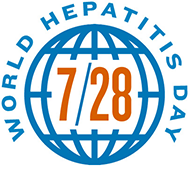LEARN MORE ABOUT WORLD HEPATITIS DAY AND HOW VIRAL HEPATITIS IMPACTS MILLIONS OF PEOPLE WORLDWIDE.
World Hepatitis Day is recognized annually on July 28th, the birthday of Dr. Baruch Blumberg (1925–2011). Dr. Blumberg discovered the hepatitis B virus in 1967, and 2 years later he developed the first hepatitis B vaccine. These achievements culminated in Dr. Blumberg winning the Nobel Prize. Organizations around the world, including WHO and CDC, commemorate World Hepatitis Day to raise awareness of the problem of viral hepatitis, which impacts more than 325 million people worldwide. It creates an opportunity to educate people about the burden of these infections, CDC’s efforts to combat viral hepatitis around the world, and actions people can take to prevent these infections. Viral hepatitis — a group of infectious diseases known as hepatitis A, B, C, D, and E — affects millions of people worldwide, causing both acute (short-term) and chronic (long-term) liver disease. Viral hepatitis causes more than one million deaths each year. While deaths from tuberculosis and HIV have been declining, deaths from hepatitis are increasing.WHAT IS CDC DOING TO HELP COMBAT HEPATITIS GLOBALLY?

Dr. Muazzam Nasrullah, Medical Officer, conducting a site visit in urban slums of Islamabad, Pakistan
The vision of CDC is to eliminate viral hepatitis in the United States and globally. When resources permit, CDC collaborates with international partners to help countries experiencing high rates of infection prevent and control viral hepatitis. For example, to decrease the burden of hepatitis B infection, CDC provides financial and technical assistance to immunization programs within high-burden countries, like those in the Solomon Islands external icon, Philippines, Vietnam, Myanmar, Cambodiaexternal icon, Sierra Leone, Pacific Islands, Laos, and Haiti external icon. Activities supported include:
- Implementing innovative interventions to increase hepatitis B vaccine coverage at birth;
- Documenting the burden of hepatitis B in children; and
- Supporting regions and countries in verifying the achievement of hepatitis B control and elimination goals.
WHAT ARE THE DIFFERENT TYPES OF HEPATITIS OCCURRING AROUND THE WORLD?
The five hepatitis viruses – A, B, C, D, and E – are distinct and can spread in different ways, affect different populations, and result in different health outcomes. Hepatitis A is a vaccine-preventable liver infection caused by the hepatitis A virus (HAV).
HAV is found in the stool and blood of people who are infected. Hepatitis A is very contagious. It is spread when someone unknowingly ingests the virus — even in microscopic amounts — through close personal contact with an infected person or through eating contaminated food or drink. Symptoms of hepatitis A can las t up to 2 months and include fatigue, nausea, stomach pain, and jaundice. Most people with hepatitis A do not have long-lasting illness. The best way to prevent hepatitis A is to get vaccinated.
Hepatitis B is a vaccine-preventable liver infection caused by the hepatitis B virus (HBV). Hepatitis B is spread when blood, semen, or other body fluids from a person infected with the virus enters the body of someone who is not infected. This can happen through sexual contact; sharing needles, syringes, or other drug-injection equipment; or from mother to baby at birth. Not all people newly infected with HBV have symptoms, but for those that do, symptoms can include fatigue, poor appetite, stomach pain, nausea, and jaundice. For many people, hepatitis B is a short-term illness. For others, it can become a long-term, chronic infection that can lead to serious, even life-threatening health issues like cirrhosis or liver cancer. Risk for chronic infection is related to age at infection: about 90% of infants with hepatitis B go on to develop chronic infection, whereas only 2%–6% of people who get hepatitis B as adults become chronically infected. The best way to prevent hepatitis B is to get vaccinated.
Hepatitis C is a liver infection caused by the hepatitis C virus (HCV). Hepatitis C is spread through contact with blood from an infected person. Today, most people become infected with the hepatitis C virus by sharing needles or other equipment used to prepare and inject drugs. For some people, hepatitis C is a short-term illness, but for more than half of people who become infected with the hepatitis C virus, it becomes a long-term, chronic infection. Chronic hepatitis C can result in serious, even life-threatening health problems like cirrhosis and liver cancer. People with chronic hepatitis C can often have no symptoms and don’t feel sick. When symptoms appear, they often are a sign of advanced liver disease. There is no vaccine for hepatitis C. The best way to prevent hepatitis C is by avoiding behaviors that can spread the disease, especially injecting drugs. Getting tested for hepatitis C is important, because treatments can cure most people with hepatitis C in 8 to 12 weeks.
Hepatitis D, also known as “delta hepatitis,” is a liver infection caused by the hepatitis D virus (HDV). Hepatitis D only occurs in people who are also infected with the hepatitis B virus. Hepatitis D is spread when blood or other body fluids from a person infected with the virus enters the body of someone who is not infected. Hepatitis D can be an acute, short-term infection or become a long-term, chronic infection. Hepatitis D can cause severe symptoms and serious illness that can lead to life-long liver damage and even death. People can become infected with both hepatitis B and hepatitis D viruses at the same time (known as “coinfection”) or get hepatitis D after first being infected with the hepatitis B virus (known as “superinfection”). There is no vaccine to prevent hepatitis D. However, prevention of hepatitis B with hepatitis B vaccine also protects against future hepatitis D infection.
Hepatitis E is a liver infection caused by the hepatitis E virus (HEV). HEV is found in the stool of an infected person. It is spread when someone unknowingly ingests the virus – even in microscopic amounts. In developing countries, people most often get hepatitis E from drinking water contaminated by feces from people who are infected with the virus. In the United States and other developed countries where hepatitis E is not common, people have gotten sick with hepatitis E after eating raw or undercooked pork, venison, wild boar meat, or shellfish. In the past, most cases in developed countries involved people who have recently traveled to countries where hepatitis E is common. Symptoms of hepatitis E can include fatigue, poor appetite, stomach pain, nausea, and jaundice. However, many people with hepatitis E, especially young children, have no symptoms. Except for the rare occurrence of chronic hepatitis E in people with compromised immune systems, most people recover fully from the disease without any complications. No vaccine for hepatitis E is currently available in the United States.
CLICK HERE TO SEE FULL ARTICLE ON THE CDC WEBSITE



